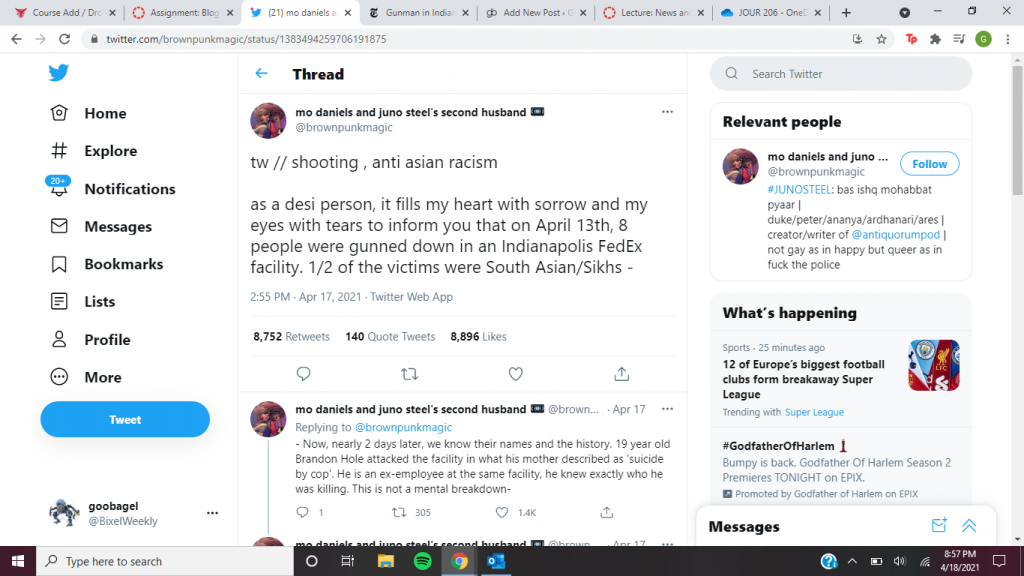The Journalists
On April 15th, 2021, a domestic terrorist by the name of Brandon Scott Hole arrived at the Indianapolis FedEx distribution center, the second largest in the US, and his former employer. At around 11p.m. the gunman “appeared to randomly start shooting” according to The New York Times. After killing at least four, he walked into the facility, then killed at least four more. In total, at least 8 people were killed, with 5 more being injured.
I first learned about this tragic event on the morning of April 16th, from my YouTube feed. The story was by The New York Times, and led to the link I provided above. This story hit especially close to home, quite literally. I’ve lived on the south-east side of Indy for the majority of my life, and although I’ve since moved, I still heavily identify with the area. For those not from the area, the south side of Indy is known for its large Sikh and Chin population. In the attack, 4 Sikhs were killed, and with the popularity of the “Stop Asian Hate” movement, some took to Twitter to show their support to the victims, and the Sikh community. One of which was @brownpunkmagic, who posted this thread on twitter, focusing on the disproportionately large amount of Sikhs killed in the attack, writing: “This is racism, pure and simple.” @brownpunkmagic garnered up over 8 thousand likes on this thread as of April 18th.

The Reporting
While these two sources are obviously very different, how does the very fundamentals of their reporting differ? Starting with the more traditional source, The New York Times presents a very factual and non-politically fueled look a the story. However, that is just one of their over 5 articles based on the attack. That being 5 articles in only 2 days. Clicking this link and looking at the top of the page, one will find links to 4 more articles (or videos) related to the case, and all other mass shootings in the US this year.
In Kimberly Lauffer’s News and Social Media lecture, a persistent storyteller is described as one who sticks with a story: a journalist or group of journalists that report every update, incident, or change in a newsworthy event. I believe the New York Times show a great example of a persistent journalism in their coverage of the Indianapolis FedEx shooting, as well as many other mass shootings in the United States. This is shown not only with the sheer amount of reporting done on the subject, but also the depth of the reporting, as well as the relative lack of bias by the reporters. The New York Times got perspective from the victims, family of victims, local and national politicians, and even the shooter’s family.
On the other hand, @brownpunkmagic’s tweet thread was much less persistent and in depth. One could even point to the incorrect date in the tweet referencing when the shooting happened as proof of the tweet’s lack of attention to accuracy. Small mistakes and typos like the one in the tweet might be part of the reason that the majority of Americans “expect the information they see on the internet to be largely inaccurate.” according to Pew Research Center.
Typos aside, with the strong language, single-sided argument, and matters of opinion without provided evidence, I believe this tweet is a great example of an information filter. This is not to say that I disagree or agree with what the tweet is saying, but the tweet’s primary goal is to promote a message of mourning, and the movement Stop Asian Hate. The author writes:
“as a Hindu Desi person who has experienced the cruelty of this country one too many times, my heart goes out to the victim’s friends and family, and all my Sikh siblings.”
What it means
The idea of Influencer’s being sources for information and news, usually to push a cause or an agenda, is an interesting idea. Many complain about CNN, MSNBC, OAN, and FOX being information filters, but almost nothing is more biased than individuals. Currently, @brownpunkmagic’s tweet is standing at 8.8k likes, and 242 retweets. Tens of thousands of people have seen this tweet, and for many, it might be their only exposure to the news. On the opposite side of the spectrum, the New York Times have been extremely in-depth, relatively unbiased, and persistent in their reporting. Many of The Times’ readers have been exposed to a lot of information about the shooting. Overall, I always support unbiased reporting, especially when said reporting is accurate. I actually agree for the most part with what @brownpunkmagic is saying in their tweet, but I don’t like the idea of people using this tweet as their only source, and I don’t like filtering information.


Leave a Reply